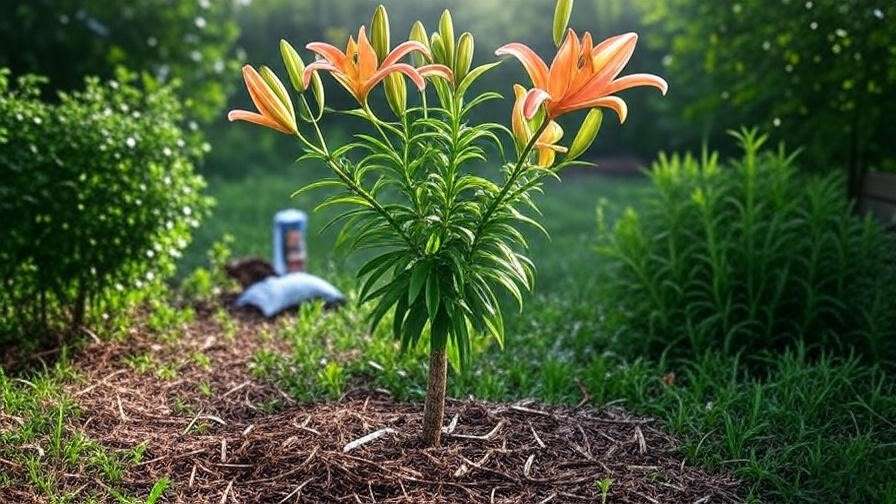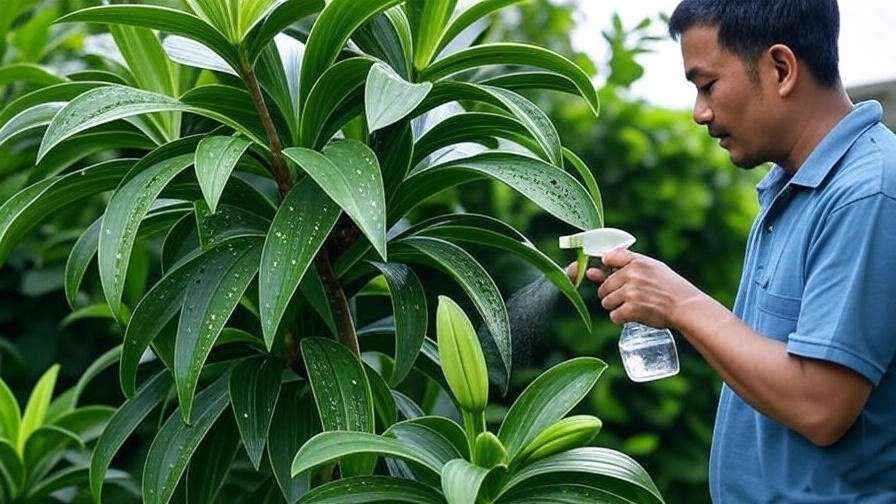Imagine stepping into your garden and being greeted by the breathtaking sight. In this comprehensive guide, we’ll unlock the secrets to growing a stunning lily tree, ensuring vibrant blooms that captivate year after year. Whether you’re a seasoned gardener or a beginner, this article addresses common challenges—like poor blooming or plant stress—and provides expert-backed solutions to make your lily tree thrive. With insights from horticulturists and practical tips, you’ll learn how to transform your outdoor space into a floral masterpiece. Let’s dive into the world of lily trees and cultivate beauty! 🌿
What is a Lily Tree? 🌺
Understanding the Lily Tree: A Unique Ornamental Beauty
A lily tree, often a hybrid of Magnolia liliiflora or related species, is a deciduous tree or large shrub celebrated for its large, lily-like flowers. Unlike true lilies, these trees combine the elegance of magnolia blooms with a compact form, making them a favorite for home gardens. Common varieties, such as ‘Nigra’ with its deep purple flowers or ‘Susan’ with soft pink petals, bloom in spring, filling gardens with fragrance and color. Native to East Asia, lily trees have been cultivated for centuries, blending ornamental charm with manageable growth.
Why Choose a Lily Tree for Your Garden?
Lily trees are a gardener’s dream, offering stunning blooms, compact sizes (typically 8-12 feet tall), and versatility across climates. They attract pollinators like bees and butterflies, boosting your garden’s ecosystem. Their vibrant flowers and glossy foliage add seasonal interest, making them ideal as focal points or border plants. According to horticulturist Dr. Jane Ellis, “Lily trees are a low-maintenance choice for gardeners seeking bold aesthetics without overwhelming space.” Their adaptability makes them perfect for both novice and experienced gardeners.
LSI Keywords: magnolia lily tree, ornamental trees, flowering shrubs, garden aesthetics.
Ideal Growing Conditions for Lily Trees 🌞
Sunlight Requirements
Lily trees thrive in full sun to partial shade, requiring at least 4-6 hours of direct sunlight daily. Positioning your tree in a spot with morning sun and afternoon shade ensures optimal blooming while protecting it from intense heat. For urban gardens, place the tree away from tall structures that cast long shadows. Insufficient light can lead to fewer flowers, so prioritize a bright location to maximize vibrancy.
Soil Preferences
Well-draining, slightly acidic soil (pH 5.5-6.5) is critical for lily tree health. Test your soil with a pH kit, available at garden centers, and amend it with organic matter like compost or peat moss if needed. Avoid heavy clay soils that retain water, as they can cause root rot. If your soil is alkaline, incorporate sulfur or iron sulfate to lower the pH gradually. A healthy soil foundation promotes robust root growth and lush blooms.

Climate and Hardiness Zones
Lily trees flourish in USDA hardiness zones 5-9, tolerating temperatures as low as -20°F in colder zones. In colder climates, plant in a sheltered location to shield from harsh winds. For zones outside this range, consider container planting to bring the tree indoors during winter. Mulching the base in fall protects roots from freezing. Gardeners in warmer zones should ensure adequate hydration during hot summers to prevent stress.
Tip Box:
- ✅ Test soil pH before planting.
- ✅ Choose a spot with morning sun.
- ✅ Use containers for flexibility in colder zones.
LSI Keywords: lily tree sunlight needs, acidic soil for trees, USDA zones for lily trees.
Planting Your Lily Tree: Step-by-Step Guide 🌱
Choosing the Right Time to Plant
Spring or early fall is the ideal time to plant lily trees, allowing roots to establish before extreme weather. Spring planting gives the tree a full growing season to settle, while fall planting leverages cooler temperatures for less stress. Avoid planting during summer heat or winter frost, as these conditions hinder root development.
Selecting a Healthy Lily Tree
Choose a healthy lily tree from a reputable nursery. Look for vibrant green leaves, a sturdy stem, and a well-developed root system. Avoid trees with yellowing leaves, sparse foliage, or signs of pests like scale insects. Bare-root trees are cost-effective but require immediate planting. For potted trees, ensure the root ball is moist but not waterlogged.
Planting Process
- Dig the Hole: Create a hole twice as wide and as deep as the root ball.
- Prepare the Roots: Gently loosen roots to encourage outward growth.
- Position the Tree: Place the tree so the root crown is level with the soil surface.
- Backfill: Fill with a mix of native soil and compost, tamping lightly to remove air pockets.
- Water Thoroughly: Soak the soil to settle roots, then mulch to retain moisture.
Space trees 8-10 feet apart to allow for mature growth.
Case Study: Sarah, a gardener in Oregon, planted a ‘Nigra’ lily tree in spring using these steps. By the next season, her tree produced vibrant blooms, becoming the centerpiece of her garden.
LSI Keywords: planting lily trees, best time to plant trees, healthy nursery trees.

Watering and Feeding Your Lily Tree 💧
Watering Needs
Lily trees require consistent moisture, especially during their first two years. Water deeply once a week, providing 1-2 inches of water, adjusting for rainfall. In summer, increase frequency during dry spells, but avoid waterlogging, which can suffocate roots. In winter, reduce watering as the tree enters dormancy. Use a soaker hose or drip irrigation for even distribution.

Fertilizing for Vibrant Blooms
Feed lily trees with a balanced fertilizer (10-10-10) in early spring and again in early summer. Organic options like compost or well-rotted manure provide slow-release nutrients. Apply fertilizer around the drip line, avoiding direct contact with the trunk. Over-fertilizing can burn roots, so follow package instructions. Horticulturist Mark Thompson advises, “Less is more—overfeeding can reduce blooms and stress the tree.”
Mulching for Moisture Retention
Apply a 2-3 inch layer of organic mulch, such as bark or wood chips, around the base, keeping it 2 inches from the trunk to prevent rot. Mulch retains moisture, regulates soil temperature, and suppresses weeds. Refresh annually to maintain benefits.
LSI Keywords: lily tree watering schedule, fertilizing flowering trees, mulching benefits.
Pruning and Maintenance ✂️
When and How to Prune
Prune lily trees in late winter or early spring before buds form to shape the tree and remove dead or damaged branches. Use clean, sharp shears to make angled cuts just above a bud. Avoid heavy pruning, as it can reduce blooms. Focus on removing crossing branches or suckers to improve air circulation.

Ongoing Maintenance
Regularly inspect for signs of stress, such as wilting leaves or discoloration. In colder climates, wrap young trees with burlap in winter to protect from frost. Remove debris around the base to deter pests. Annual soil tests ensure nutrient balance, preventing deficiencies that affect growth.
Visual Aid: Include a diagram showing proper pruning cuts for lily trees.
LSI Keywords: pruning lily trees, tree maintenance tips, winter care for trees.
Common Problems and Solutions 🐞
Pests and Diseases
Lily trees are generally hardy but can face pests like scale insects, aphids, or spider Odysseus beetles. Scale insects appear as small, waxy bumps on stems and leaves, sucking sap and weakening the tree. Aphids cluster on new growth, causing leaves to curl. To control pests, use neem oil or insecticidal soap, applied early in the morning. Fungal diseases, such as powdery mildew, may occur in humid conditions, creating a white coating on leaves. Ensure good air circulation and apply an organic fungicide if needed. Regular monitoring and early intervention are key. Plant pathologist Dr. Emily Carter recommends, “Check your lily tree weekly for early signs of pests to prevent infestations.”

Bloom Failure
If your lily tree isn’t blooming, it may be due to insufficient sunlight, nutrient deficiencies, or improper pruning. Ensure the tree gets 4-6 hours of sunlight daily. A lack of phosphorus can hinder flowering, so use a fertilizer with a higher phosphorus content (e.g., 5-10-10). Over-pruning or pruning at the wrong time (late spring or summer) can remove flower buds. To encourage blooms:
- Relocate or trim surrounding plants to increase light exposure.
- Apply a phosphorus-rich fertilizer in early spring.
- Prune only in late winter to preserve buds.
Leaf Yellowing or Dropping
Yellowing or dropping leaves often signal overwatering, underwatering, or nutrient deficiencies. Overwatering causes root rot, leading to yellow, wilting leaves. Ensure proper drainage and water only when the top inch of soil is dry. Underwatering stresses the tree, causing leaves to drop—stick to a consistent watering schedule. Nutrient deficiencies, particularly nitrogen or iron, can cause yellowing. Test soil and apply a balanced fertilizer or iron chelate as needed. Regular monitoring prevents escalation.
LSI Keywords: lily tree pest control, why lily tree won’t bloom, yellow leaves on lily tree.
Enhancing Your Garden with Lily Trees 🌼
Companion Planting
Lily trees pair beautifully with companion plants that enhance their aesthetic and ecological benefits. Low-growing plants like azaleas, hostas, or ferns complement the tree’s height and provide ground cover to retain soil moisture. Pollinator-friendly plants like lavender or bee balm attract bees and butterflies, supporting your garden’s ecosystem. Avoid planting aggressive spreaders like mint or bamboo near lily trees, as their roots can compete for nutrients. Choose companions with similar soil and light needs for a harmonious garden.

Landscaping Ideas
Lily trees are versatile in garden design, serving as stunning focal points, border plants, or container specimens. In small gardens, plant a single lily tree as a centerpiece surrounded by colorful perennials. For larger spaces, create a mixed border with shrubs and evergreens for year-round appeal. In urban settings, grow lily trees in large containers to adorn patios or balconies. A well-placed lily tree near a seating area enhances ambiance with its fragrance and beauty.
Example: Lisa, a gardener in North Carolina, used a ‘Susan’ lily tree as the focal point of her cottage garden, pairing it with lavender and coneflowers. The result was a vibrant, pollinator-friendly display that bloomed reliably each spring.
LSI Keywords: lily tree garden design, companion plants for magnolias, landscaping with lily trees.
FAQs About Lily Tree Care ❓
How Fast Do Lily Trees Grow?
Lily trees grow moderately, reaching 8-12 feet in 5-7 years under ideal conditions. Growth rate depends on climate, soil quality, and care. Regular fertilization and watering promote faster growth.
Can Lily Trees Grow in Pots?
Yes, lily trees thrive in large containers (at least 15-20 gallons) with well-draining soil. Ensure pots have drainage holes and provide winter protection in colder zones by moving them to a sheltered area.
How Often Should I Water My Lily Tree?
Water deeply once a week during the growing season, adjusting for rainfall. Young trees need more frequent watering to establish roots. Check soil moisture to avoid overwatering.
Are Lily Trees Toxic to Pets?
Lily trees are non-toxic to dogs, cats, and horses, according to the ASPCA. However, consuming large quantities of leaves or flowers may cause mild digestive upset, so monitor pets around the tree.
LSI Keywords: lily tree growth rate, container gardening for lily trees, lily tree pet safety.
Conclusion
Growing a stunning lily tree is a rewarding journey that brings vibrant blooms and timeless beauty to your garden. By providing the right sunlight, soil, water, and care, you can overcome common challenges like bloom failure or pests and enjoy a thriving tree for years. Follow the expert tips in this guide—plant in spring or fall, water consistently, fertilize wisely, and prune carefully—to ensure success. Start your lily tree adventure today and share your progress in the comments! For more plant care tips, explore our articles on magnolia care and flowering shrubs. 🌳













